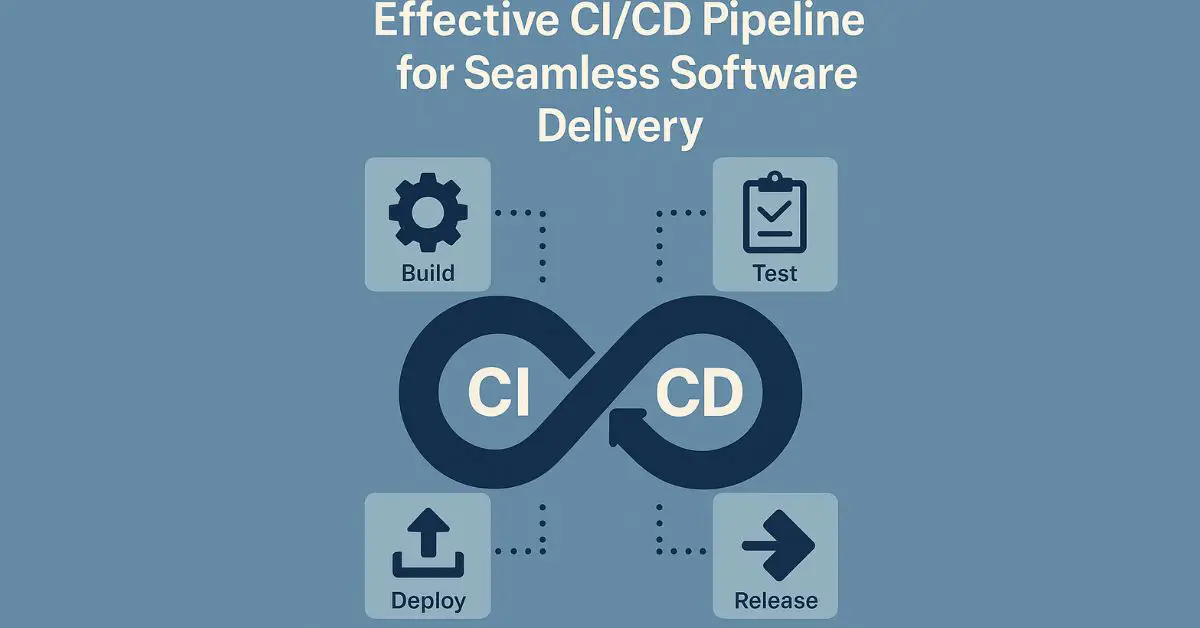Implementing a strong CI/CD pipeline isn’t just a good idea; it’s essential for staying competitive today. When done right, it speeds up releases, reduces bugs, and helps teams work smarter. Studies show that organizations with solid CI/CD setups deliver software 20-30% faster. Automation cuts down mistakes and makes product updates smoother. This guide walks you through building a reliable CI/CD pipeline step-by-step, from planning to monitoring.
Understanding CI/CD: Fundamentals and Benefits
What is Continuous Integration and Continuous Delivery/Deployment?
Continuous Integration (CI) means developers regularly merge their code into a shared repository. Every check-in triggers automatic tests and builds, catching problems early. Continuous Delivery (CD) takes it further—ensuring that software is always ready to go live. Continuous Deployment automates the entire process, pushing updates straight to users once tests pass. Unlike traditional releases, which happen in big chunks, CI/CD makes updates smaller and more manageable.
Benefits of CI/CD Pipelines
A well-structured CI/CD pipeline offers many perks:
- Faster release cycles mean users see new features quicker.
- Developers spend less time fixing bugs after deployment.
- Deployments become predictable and reliable.
- Teams can roll back changes fast if something breaks.
For example, Shopify uses CI/CD to get new features to users often and smoothly, supporting fast growth and innovation.
Common Challenges and How to Overcome Them
Getting started isn’t always easy. Infrastructure can be complex, and tooling choices matter. Resistance to change also slows teams down. Start small: automate one part at a time. Focus on early testing to catch issues fast. Encourage open communication and collaboration across teams to make the shift smoother.
Planning Your CI/CD Pipeline Architecture
Assessing Your Development Workflow and Tools
Look at what tools and processes you already have. Are you using Git for version control? Do you have a test environment? Pick tools that work well together—like Jenkins, GitLab CI, or GitHub Actions. Make sure your setup fits your team size and project needs.
Defining Objectives and Metrics
Set clear goals for your pipeline. Do you want faster releases? Fewer bugs? The ability to roll back quickly? Measure your success by how often you deploy, how many failures happen, and how fast you recover from issues.
Designing a Scalable and Secure Pipeline
Build a pipeline that grows with you. Break it into stages—code, test, deploy—so it’s flexible. Include security checks early, like automatic scans for vulnerabilities or compliance issues, so they don’t become bottlenecks later.
Building Blocks of a CI/CD Pipeline
Version Control System Integration
Your pipeline starts with code stored safely in a version control system like Git. Use branching strategies such as GitFlow or trunk-based development to keep things organized. Automate code review and merging, so code quality stays high.
Automated Build and Test Processes
Set up automatic builds that compile code whenever changes are pushed. Integrate static code analysis and run unit and integration tests automatically to find bugs early. Netflix, for example, automates testing so they can release high-quality updates regularly.
Continuous Integration Implementation
Configure your system to trigger builds whenever developers push code. This offers instant feedback, helping catch and fix errors fast. Quick feedback loops prevent small issues from snowballing into big problems.
Deployment Automation
Automatic deployment to staging environments prepares the app for real users. Use strategies like blue-green deployments, canary releases, or rolling updates to reduce downtime and risk during production updates.
Monitoring and Feedback Mechanisms
Use tools like Prometheus or Grafana to monitor your app in real-time. Collect user feedback and error reports to improve your process with each release. Regular monitoring helps catch problems early and guides future improvements.
Best Practices for Successful CI/CD Adoption
Automate Everything
From code checks to deployment, automation saves time and reduces mistakes. Make sure rollback procedures are automated as well, so you can fix issues fast.
Focus on Quality and Testing
Build a strong testing layer—you want to catch bugs before they reach users. Use test-driven development (TDD) to write tests alongside code, not after.
Maintain Infrastructure as Code
Treat your infrastructure like code. Use tools like Terraform or Ansible to set up environments. This makes setups repeatable and helps avoid configuration issues.
Foster a DevOps Culture
Encourage teamwork across developers, operations, and QA. Good communication improves pipeline efficiency and makes everyone accountable for quality.
Continuous Improvement and Optimization
Review your pipeline regularly. Are builds fast enough? Are tests catching real problems? Use feedback to refine each stage and make the process smoother.
Tools and Technologies for CI/CD Pipelines
Popular CI/CD Tools
Use tools like Jenkins, GitHub Actions, GitLab CI, CircleCI, or Travis CI. They automate the entire pipeline, making deployment faster and more reliable.
Containerization and Orchestration
Packages like Docker make sure your app runs the same everywhere. Combine Docker with Kubernetes for managing and scaling deployments smoothly.
Cloud Providers and Managed Services
Cloud solutions like AWS CodePipeline, Azure DevOps, or Google Cloud Build offer easy-to-set-up pipelines without heavy infrastructure management.
Security and Compliance Tools
Incorporate tools that scan code for vulnerabilities (SAST), test for security weaknesses (DAST), and manage secrets safely.
Real-World Case Studies
Atlassian’s Transition to CI/CD
When Atlassian moved to CI/CD, they faced hurdles like integrating old tools and changing team habits. By starting small and automating tests early, they sped up releases and cut bugs.
Spotify’s Automated Deployment Strategy
Spotify uses microservices and automation heavily. They deploy multiple times a day, supported by monitoring and quick rollback options. This keeps their service reliable and customers happy.
Conclusion
Building a solid CI/CD pipeline involves planning right, automating thoroughly, and continuously tweaking the process. It’s about making deployment quicker, safer, and more reliable. The key is to start small—automate piece by piece—and involve everyone. Continue learning and refining your pipeline as your team expands. Today’s a good day to evaluate your current setup and plan your first pipeline. Your software delivery will never be the same.
Arsalan Malik is a passionate Software Engineer and the Founder of Makemychance.com. A proud CDAC-qualified developer, Arsalan specializes in full-stack web development, with expertise in technologies like Node.js, PHP, WordPress, React, and modern CSS frameworks.
He actively shares his knowledge and insights with the developer community on platforms like Dev.to and engages with professionals worldwide through LinkedIn.
Arsalan believes in building real-world projects that not only solve problems but also educate and empower users. His mission is to make technology simple, accessible, and impactful for everyone.



